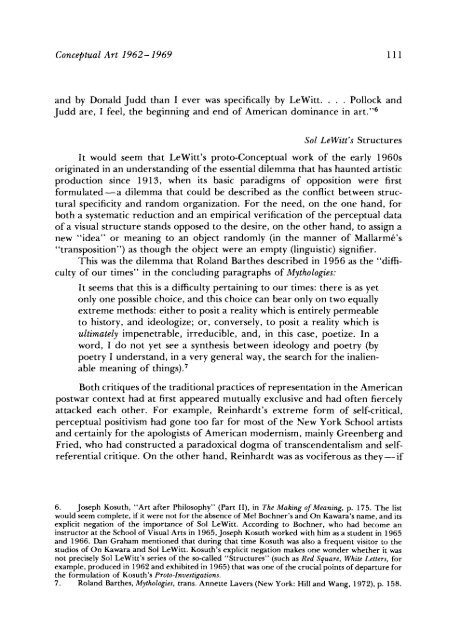Conceptual Art 1962-1969: From the Aesthetic of Administration to ...
Conceptual Art 1962-1969: From the Aesthetic of Administration to ...
Conceptual Art 1962-1969: From the Aesthetic of Administration to ...
Create successful ePaper yourself
Turn your PDF publications into a flip-book with our unique Google optimized e-Paper software.
<strong>Conceptual</strong> <strong>Art</strong> <strong>1962</strong>- <strong>1969</strong>and by Donald Judd than I ever was specifically by LeWitt. . . . Pollock andJudd are, I feel, <strong>the</strong> beginning and end <strong>of</strong> American dominance in art."6Sol LeWitt's StructuresIt would seem that LeWitt's pro<strong>to</strong>-<strong>Conceptual</strong> work <strong>of</strong> <strong>the</strong> early 1960soriginated in an understanding <strong>of</strong> <strong>the</strong> essential dilemma that has haunted artisticproduction since 1913, when its basic paradigms <strong>of</strong> opposition were firstformulated-a dilemma that could be described as <strong>the</strong> conflict between structuralspecificity and random organization. For <strong>the</strong> need, on <strong>the</strong> one hand, forboth a systematic reduction and an empirical verification <strong>of</strong> <strong>the</strong> perceptual data<strong>of</strong> a visual structure stands opposed <strong>to</strong> <strong>the</strong> desire, on <strong>the</strong> o<strong>the</strong>r hand, <strong>to</strong> assign anew "idea" or meaning <strong>to</strong> an object randomly (in <strong>the</strong> manner <strong>of</strong> Mallarmk's"transposition") as though <strong>the</strong> object were an empty (linguistic) signifier.This was <strong>the</strong> dilemma that Roland Bar<strong>the</strong>s described in 1956 as <strong>the</strong> "difficulty<strong>of</strong> our times" in <strong>the</strong> concluding paragraphs <strong>of</strong> Mythologies:It seems that this is a difficulty pertaining <strong>to</strong> our times: <strong>the</strong>re is as ye<strong>to</strong>nly one possible choice, and this choice can bear only on two equallyextreme methods: ei<strong>the</strong>r <strong>to</strong> posit a reality which is entirely permeable<strong>to</strong> his<strong>to</strong>ry, and ideologize; or, conversely, <strong>to</strong> posit a reality which isultimately impenetrable, irreducible, and, in this case, poetize. In aword, I do not yet see a syn<strong>the</strong>sis between ideology and poetry (bypoetry I understand, in a very general way, <strong>the</strong> search for <strong>the</strong> inalienablemeaning <strong>of</strong> things).'Both critiques <strong>of</strong> <strong>the</strong> traditional practices <strong>of</strong> representation in <strong>the</strong> Americanpostwar context had at first appeared mutually exclusive and had <strong>of</strong>ten fiercelyattacked each o<strong>the</strong>r. For example, Reinhardt's extreme form <strong>of</strong> self-critical,perceptual positivism had gone <strong>to</strong>o far for most <strong>of</strong> <strong>the</strong> New York School artistsand certainly for <strong>the</strong> apologists <strong>of</strong> American modernism, mainly Greenberg andFried, who had constructed a paradoxical dogma <strong>of</strong> transcendentalism and selfreferentialcritique. On <strong>the</strong> o<strong>the</strong>r hand, Reinhardt was as vociferous as <strong>the</strong>y-if6. Joseph Kosuth, "<strong>Art</strong> after Philosophy" (Part 11), in The Making <strong>of</strong>hfeaning, p. 175. The listwould seem complete, if it were not for <strong>the</strong> absence <strong>of</strong> Mel Bochner's and On Kawara's name, and itsexplicit negation <strong>of</strong> <strong>the</strong> importance <strong>of</strong> Sol LeWitt. According <strong>to</strong> Bochner, who had become aninstruc<strong>to</strong>r at <strong>the</strong> School <strong>of</strong> Visual <strong>Art</strong>s in 1965, Joseph Kosuth worked with him as a student in 1965and 1966. Dan Graham mentioned that during that time Kosuth was also a frequent visi<strong>to</strong>r <strong>to</strong> <strong>the</strong>studios <strong>of</strong> On Kawara and Sol LeWitt. Kosuth's explicit negation makes one wonder whe<strong>the</strong>r it wasnot precisely Sol LeWitt's series <strong>of</strong> <strong>the</strong> so-called "Structures" (such as Red Square, White Letters, forexample, produced in <strong>1962</strong> and exhibited in 1965) that was one <strong>of</strong> <strong>the</strong> crucial points <strong>of</strong> departure for<strong>the</strong> formulation <strong>of</strong> Kosuth's Pro<strong>to</strong>-Investigations.7. Roland Bar<strong>the</strong>s, Mythologies, trans. Annette Lavers (New York: Hill and Wang, 1972), p. 158.
















